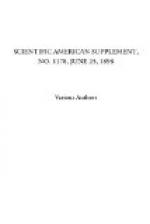Reclaimed rubber is not to be considered as an adulterant, except in the same sense as fillings, like whiting, litharge or barytes, the use of which in rubber compounds often gives to the product desirable qualities that are unobtainable by the use of “pure gum.” It lacks some of the qualities of good native rubber, and yet it is rubber, and fills its proper place as acceptably as any raw material of manufacture. Rubber shoes made of new gum entirely would be too elastic, and for that reason would draw the feet, besides being too costly for the ordinary trade. The construction of a rubber shoe, by the way, is well adapted for the use of different compounds for the different parts. Rubber enters into twenty-six pieces of a rubber boot and nine or more pieces of a rubber shoe. Consequently, as many different compounds may be used, if desired, for the output of a single factory for rubber footwear. The highest grades of native rubber may be used for waterproofing the uppers of a fine overshoe, while reclaimed rubber, of a cheap class even, may be good enough for the heel, which requires only to be waterproof and durable, without too much weight, and with no elasticity. Reclaimed rubber goes into many classes of goods of high grade. The result is that such goods have been cheapened legitimately, placing them within the reach of immense numbers of consumers who otherwise would be obliged to do without.
While the extensive use of reclaimed rubber is a matter of common knowledge to all who are familiar with the rubber industry, there are nowhere available any statistics of either the absolute or comparative volume of its consumption, with the single exception of the official returns of imports into Canada. There separate accounts are kept of crude India rubber and of recovered rubber received in each year, and as only a consuming market exists for these commodities in the Dominion, the figures given below may be taken to represent closely the actual consumption by the rubber factories of Ontario and Quebec. It is interesting to note the heavy growth of the percentage of recovered rubber shown in the table, all the figures representing pounds:
Fiscal Crude Recovered Total Year. Rubber. Rubber. Imports. 1885-86 739,169 19,499 758,668 1886-87 785,040 46,508 831,548 1887-88 1,225,893 88,471 1,314,364 1888-89 1,669,014 221,674 1,890,688 1889-90 1,290,766 147,377 1,438,143 1890-91 1,602,644 8,254 1,610,898 1891-92 2,100,358 106,080 2,206,438 1892-93 2,152,855 195,281 2,348,136 1893-94 2,077,703 529,900 2,607,603 1894-95 1,402,844 611,745 2,014,589 1895-96 2,155,576 643,169 2,798,745 1896-97 2,014,936 1,061,402 3,076,338




